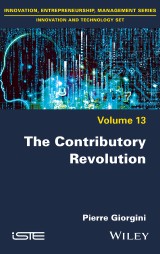Details

The Contributory Revolution
1. Aufl.
|
139,99 € |
|
| Verlag: | Wiley |
| Format: | EPUB |
| Veröffentl.: | 22.09.2021 |
| ISBN/EAN: | 9781119866343 |
| Sprache: | englisch |
| Anzahl Seiten: | 256 |
DRM-geschütztes eBook, Sie benötigen z.B. Adobe Digital Editions und eine Adobe ID zum Lesen.
Beschreibungen
This book sheds light on a crucial debate on the possible role of the technosciences in meeting the challenges of the future. It shows that the current contributory revolution is global and profound, and that it concerns the whole epistemological field - from the sciences to social organizations. By delving into the epistemological dimension of the lightning transition we are currently experiencing, The Contributory Revolution identifies the levers of the salutary acceleration of collective learning, now essential, but not before the debate on a possible future has been settled via the headlong rush of the technoscientist.<br /><br />However, after this call to move from exo-distributive technoscience, carried by deterministic and Newtonian models, to more biological and endocontributory models - or even from the arrogance of mastery to the humility of influence and alliance - it will be necessary to set its limits to avoid entering into an eco-philosophical radicalism. Only extreme humility, carried by strong spirituality, can protect us from it.
<p>Foreword ix<br /><i>Jeremy RIFKIN</i></p> <p>Preface xi</p> <p>Acknowledgments xiii</p> <p>Introduction xv</p> <p><b>Chapter 1. The Major Dualities in How Things are Perceived </b><b>1</b></p> <p>1.1. Examples to illustrate the ongoing transition 3</p> <p>1.1.1. Intelligent textiles 3</p> <p>1.1.2. From the solar system to the infinitely small 3</p> <p>1.1.3. The collective intelligence of working groups 6</p> <p>1.1.4. Medicine as a playing field for this duality 8</p> <p>1.2. Our relationship to power is in question 11</p> <p>1.3. Our relationship to language is in question 14</p> <p>1.4. The epistemological mutation of the sciences. 15</p> <p><b>Chapter 2. Science and Sense, Places and Links </b><b>23</b></p> <p>2.1. The salutary crisis of meaning 23</p> <p>2.2. The duality of places and links 28</p> <p>2.2.1. The duality of place and link in our relationship to all things 28</p> <p>2.2.2. The place/link duality and the noosphere (global network of consciousness) 32</p> <p>2.2.3. The place/link duality and the biosphere 34</p> <p>2.3. The metamorphosis of science as a cultural object 36</p> <p>2.4. The crisis of joy 37</p> <p><b>Chapter 3. Contributory Metamorphosis in the Conception of Systems and the Sciences </b><b>41</b></p> <p>3.1. Introduction 41</p> <p>3.1.1. When Einstein, Wiener and Turing make us dance on a volcano 44</p> <p>3.2. The hypothesis of a science claiming to explain everything about visible reality 51</p> <p>3.3. From the digital revolution to the quantum revolution 53</p> <p>3.3.1. Poetic prose of the wave and the corpuscle 53</p> <p>3.3.2. The digital revolution 57</p> <p>3.3.3. The quantum mystery 58</p> <p>3.3.4. Wave or corpuscle? 60</p> <p>3.4. The convergence of physics, cybernetics and digital sciences 62</p> <p>3.4.1. Could the wave overcome the corpuscle? 65</p> <p>3.4.2. The underlying fantasies implied by a new technoscientific era 68</p> <p>3.5. Subjectivity, incompleteness, unpredictability and indeterminacy in science 72</p> <p>3.5.1. Uncertainty and intersubjectivity in science 72</p> <p>3.5.2. Incompleteness in science 74</p> <p>3.5.3. Unpredictability in science 76</p> <p>3.6. The case of economic sciences 82</p> <p>3.6.1. Unforeseeability in economics/finance 82</p> <p>3.7. Critical notes on the hypothesis of a unified science of visible reality 85</p> <p>3.7.1. Phenomenological metaphor 85</p> <p>3.7.2. Humans harness electromagnetic waves 86</p> <p>3.7.3. Is a “unified scientific theory of the knowable” still on its way? 88</p> <p>3.7.4. Is the “unified scientific theory of the knowable” developing as a belief? 89</p> <p>3.8. Understanding what it means to understand 94</p> <p>3.9. Science pushed to the limits, the limits of science 106</p> <p>3.10. Conclusion 110</p> <p><b>Chapter 4. The Contributory Metamorphosis of Technical Progress </b><b>113</b></p> <p>4.1. Introduction 113</p> <p>4.2. Confession: the suicidal race to technical intensity 116</p> <p>4.3. A short history, from geosphere to technical civilization 124</p> <p>4.3.1. The revolution of the living world 126</p> <p>4.3.2. The revolution of consciousness 127</p> <p>4.4. The five stimulants of the “technological bluff” 131</p> <p>4.4.1. “Pseudo-humanist reductionism” is spreading and becoming dominant 131</p> <p>4.4.2. Distancing from collateral damage to nature 134</p> <p>4.4.3. The separation of use, design and the production of goods 135</p> <p>4.4.4. Technology becomes an object of enjoyment in itself, and develops its own narrative, a true technomythology 136</p> <p>4.4.5. Value confused with price, in ideas of the market 137</p> <p>4.5. The case of robotics and artificial intelligence 142</p> <p>4.5.1. Metaphor of pattern recognition to understand different artificial intelligence machines 142</p> <p>4.5.2. Critique of the contemporary narrative of modernity relating to robotics derived from artificial intelligence 144</p> <p><b>Chapter 5. The Salutary Crisis of Joy </b><b>155</b></p> <p>5.1. The demolition of places 155</p> <p>5.2. The living world, an example to follow 165</p> <p>5.3. A saving antidote to the general crisis of meaning 167</p> <p>5.4. The path of complexity – ethics of organized complexity 169</p> <p>5.5. Third places, co-elaborative spaces that integrate meaning 171</p> <p>5.6. Is an endo-contributive economy possible? (Human capital and full human development) 173</p> <p>5.6.1. Rivalry or exclusion? Club property and common property 173</p> <p>5.6.2. From collectivity to community 175</p> <p>5.6.3. Fair or effective communities? 176</p> <p>5.6.4. The emergence of a contributory economy 177</p> <p>5.6.5. Human capital at the heart of the contributory economy 179</p> <p>5.7. Is endo-contributive energy possible? 182</p> <p>5.7.1. Towards the decentralization of electricity networks 182</p> <p>5.7.2. Smart grids? 183</p> <p>5.7.3. Consum-actors for an endo-contributory management of networks? 184</p> <p>5.7.4. Blockchain: information and communication systems for peer-to-peer exchanges. A step towards an endo-contributive approach to energy? 185</p> <p>5.8. Is endo-contributive agriculture possible? 187</p> <p>5.9. Is endo-contributory technoscience possible? 189</p> <p>Conclusion: The Limits of the Thesis 191</p> <p>Postface 193<br /><i>Maël MONTÉVIL</i></p> <p>Appendix: Scientific and Philosophical Comments 199</p> <p>References 205</p> <p>Index 211</p>
<b>Pierre Giorgini</b> is the former Deputy Chief Executive Officer of Orange Innovation and Research and the former Rector at the Catholic University of Lille, France. He is an Associate Researcher in the ETHICS (Ethics on experiments, Transhumanism, Human Interactions, Care & Society) research unit and the author of numerous books on "ethics and technologies".


















